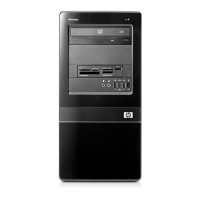Short description Details Solution
4. Click when Java Card/token is inserted.
5. Select the Advise to log-on checkbox.
Users lose all Credential
Manager credentials
protected by the TPM, if
the TPM module is
removed or damaged.
If the TPM module is removed or
damaged, users lose all credentials
protected by the TPM.
This is as designed.
The TPM Module is designed to protect the Credential
Manager credentials. HP recommends that the user
back up identity from Credential Manager prior to
removing the TPM module.
Credential Manager not
being set as primary logon
in Windows 2000.
During Windows 2000 install, the logon
policy is set for manual or auto logon
admin. If auto logon is chosen, then the
Windows default registry settings sets
the default auto admin logon value at 1,
and Credential Manager does not
override this.
This is as designed.
If user wishes to modify operating system level settings
for auto admin logon values for bypassing the edit path
is HKEY_LOCAL_MACHINE/Software/Microsoft/
WindowsNT/CurrentVersion/WinLogon
CAUTION Use Registry Editor at your own
risk! Using the Registry Editor (regedit)
incorrectly can cause serious problems that
may require you to reinstall the operating
system. There is no guarantee that problems
resulting from the incorrect use of Registry
Editor can be solved.
Fingerprint logon
message appears
whether or not fingerprint
reader is installed or
registered.
If user selects Windows logon, the
following desktop alert appears in the
Credential Manager task bar: You can
place your finger on the fingerprint
reader to log on to Credential
Manager.
The purpose of the desktop alert is to notify the user
that fingerprint authentication is available, if it is
configured.
Credential Manager logon
window for Windows 2000
states insert card when
no reader is attached.
The Windows Credential Manager
Welcome screen suggests the user can
log on with insert card when no Java
Card reader is attached.
The purpose of the alert is to notify the user that Java
Card authentication is available, if it is configured.
Unable to log into
Credential Manager after
transitioning from sleep
mode to hibernation on
Windows XP Service Pack
1 only.
After allowing system to transition into
hibernation and sleep mode,
Administrator or user is unable to log into
Credential Manager and the Windows
logon screen remains displayed no
matter which logon credential
(password, finger print or Java Card) is
selected.
This issue appears to be resolved in Service Pack 2
from Microsoft. Refer to Microsoft knowledge base
article 813301 at
http://www.microsoft.com for more
information on the cause of the issue.
In order to log on, user must select Credential Manager
and log in. After logging into Credential Manager, user
is prompted to log in to Windows (user may have to
select the Windows login option) to complete login
process.
If user logs into Windows first, then user must manually
log into Credential Manager.
Restoring Embedded
Security causes
Credential Manager to fail.
Credential Manager fails to register any
credentials after the ROM is restored to
factory settings.
The HP Credential Manager for ProtectTools fails to
access the TPM if the ROM was reset to factory settings
after the Credential Manager installation.
The TPM embedded security chip can be enabled in the
BIOS Computer Setup utility, BIOS Configuration for
ENWW Credential Manager for ProtectTools 25

